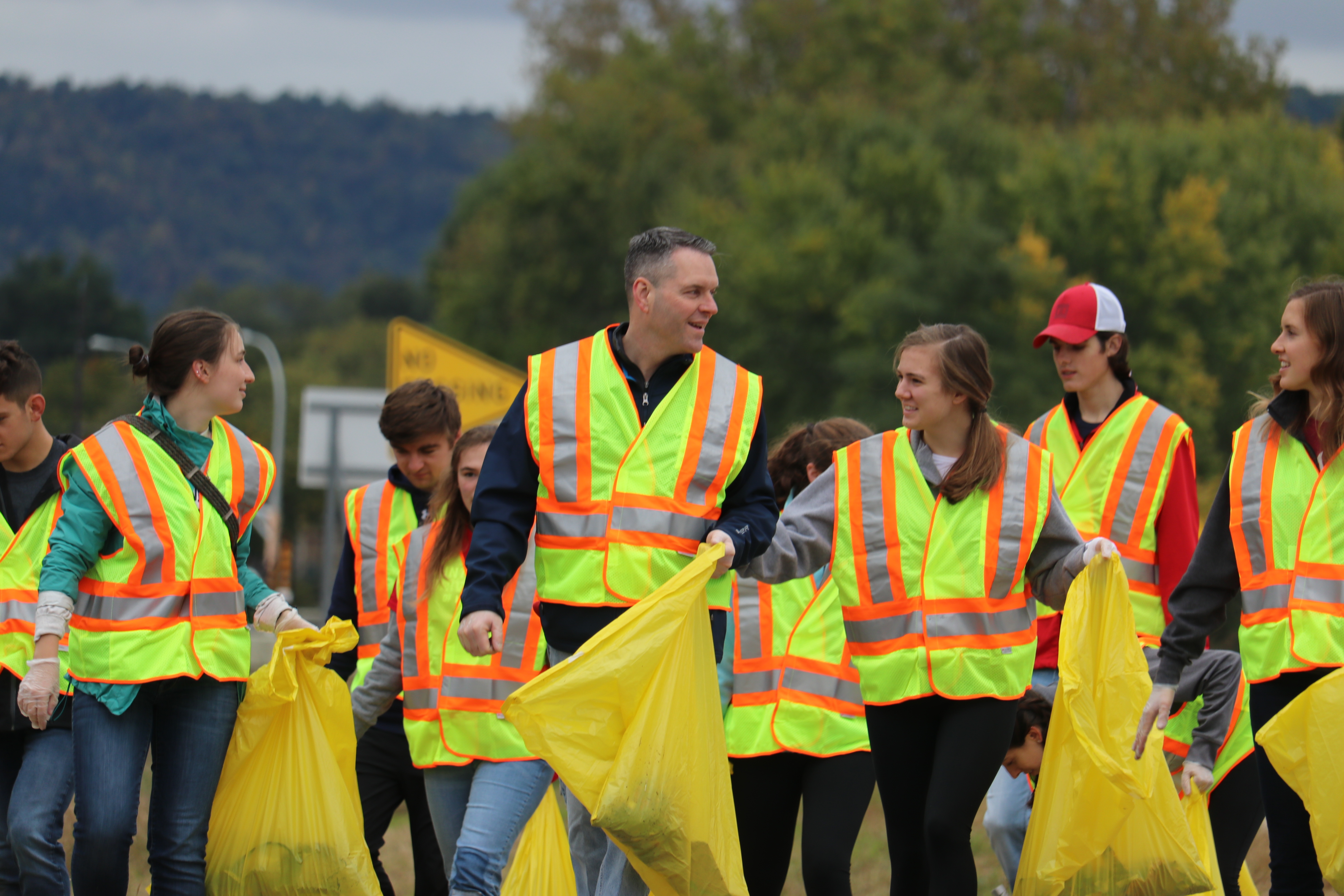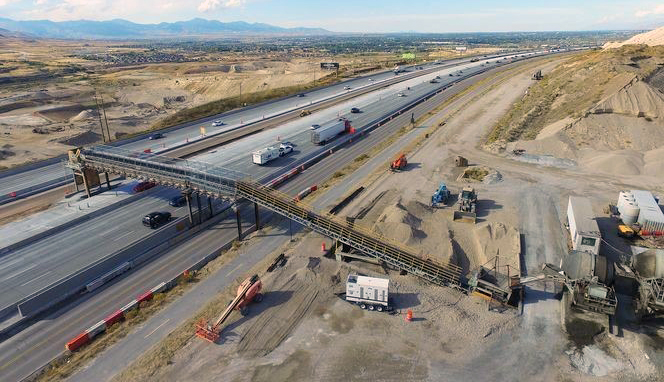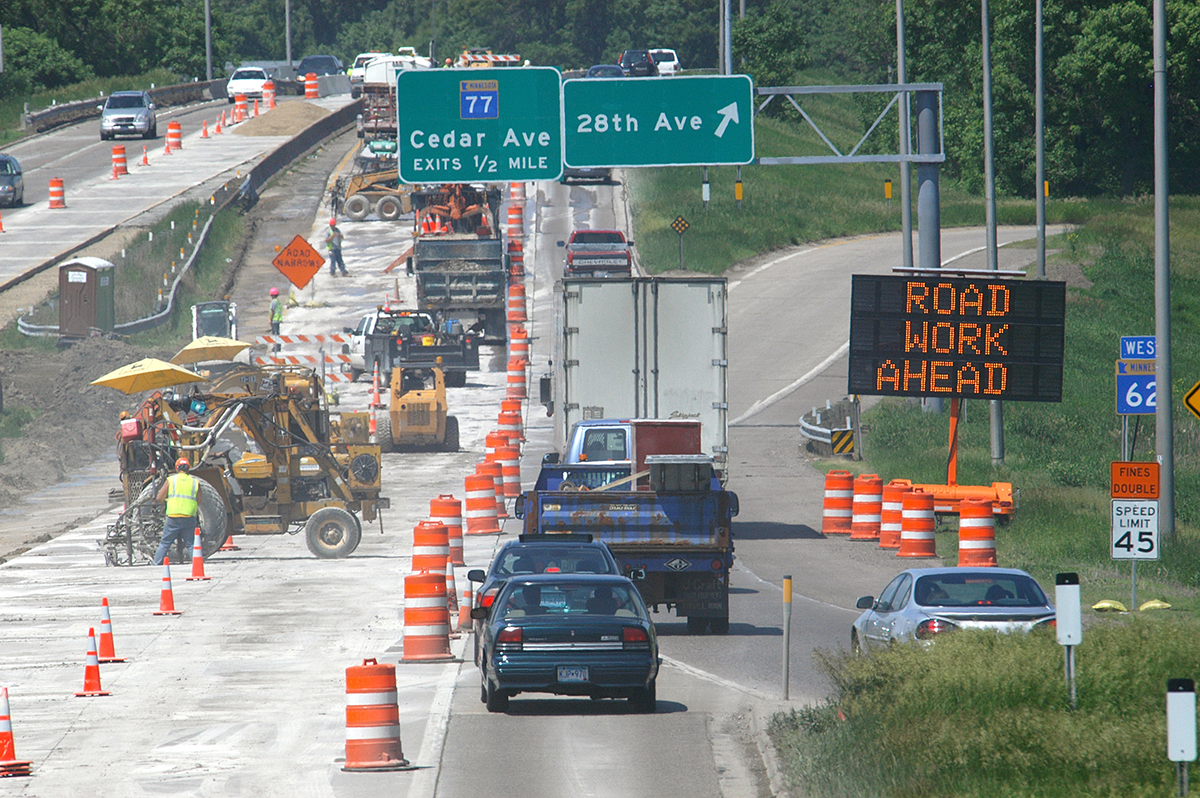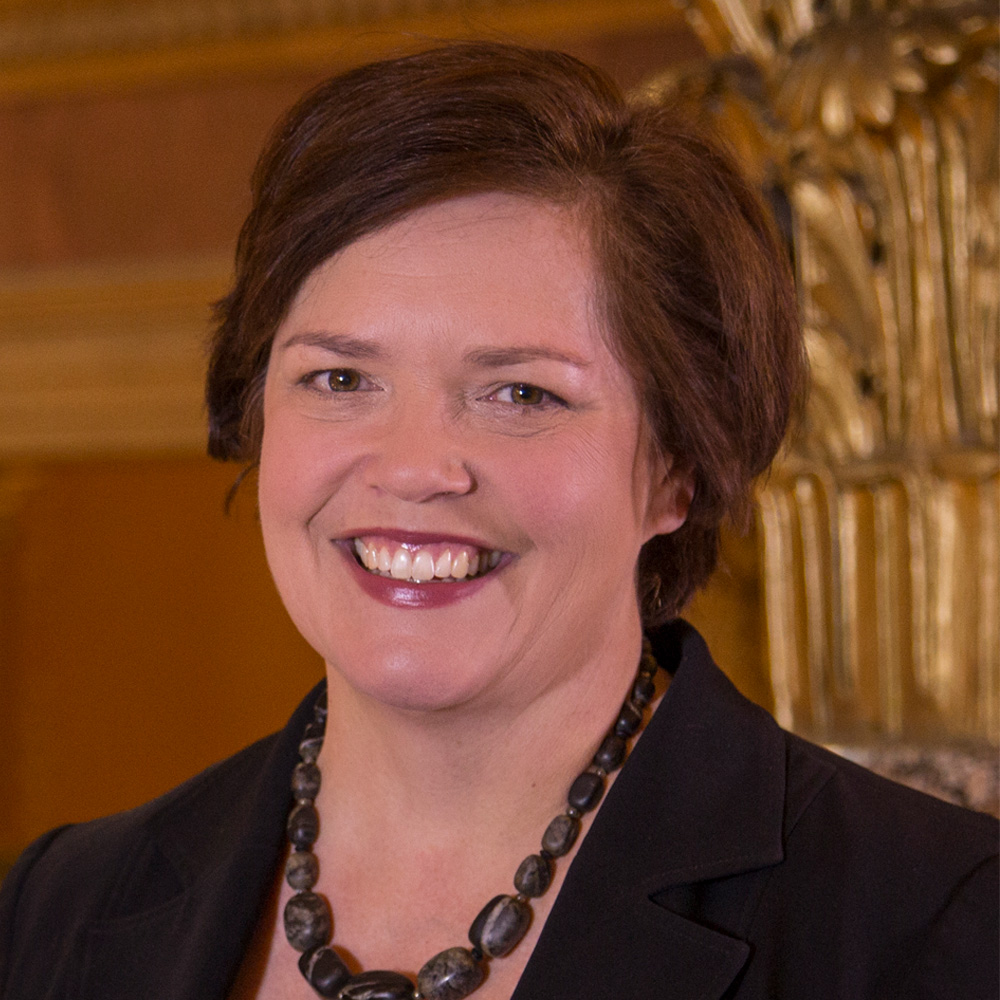 |
|

|
 |
TABLE of CONTENTS
 |
Adopt a Highway program celebrates 30 years of cleaner roadsides |

Volunteers with Adopt a Highway have cleaned a section of Hwy 14 near St. Mary's University of Minnesota in District 6 since the program started more than 30 years ago. (Note: this photo was taken before the COVID-19 pandemic) Photo courtesy of St. Mary's University of Minnesota |
By Anne Meyer
When the Lakers 4-H club cleans up litter along Hwy 91 in Murray County, none of the children with bags in hand were born in 1990, the year MnDOT’s Adopt a Highway program started. Neither were the college students at St. Mary's University of Minnesota who pick up trash near campus along Hwy 14 near Winona. Still, these organizations are just a few of the 475 groups across Minnesota that have volunteered with the program all 30 years.
MnDOT’s AAH program began after then-Gov. Rudy Perpich visited Texas to speak with Lady Bird Johnson about the state’s anti-litter campaign, called “Don’t Mess with Texas.” MnDOT’s then-Commissioner Len Levine allocated budget to kick-off the project and traveled the state with Perpich to help sign up volunteers.
Today, about 3,800 volunteer groups, ranging from four to 25 people, work with AAH statewide. In 2019, those volunteers spent an estimated 272,000 hours cleaning Minnesota ditches, picking up at least 40,000 bags of trash. This translates into an estimated $7 million in realized benefit for the state.
“The Adopt a Highway program is proof that Minnesotans care about their state,” said Ann McLellan, statewide Adopt a Highway manager. “Volunteers picking up litter along our roadways also allows our MnDOT crews to focus on other work, like repairing guardrails, mowing and keeping highways safe.”
McLellan said the program would not be successful without an army of internal support. District AAH coordinators work directly with volunteers to coordinate picks, supplies and the paperwork needed for each group. Maintenance staff help with supplies and pick up the filled trash bags along the highways or anything else too big for volunteers to handle themselves. The sign shop helps, too, by creating the AAH signs honoring each volunteer group along their adopted highway section.
“It’s a huge team effort. We can’t thank our teams enough for this work and dedication as we celebrate 30 years strong of our Adopt a Highway program,” McLellan added.
Volunteers are asked to commit to the program for at least two years and pick up litter on both sides of the roadway a minimum of twice a year. The average length of an adopted roadway is two miles. MnDOT provides volunteers with safety training, including new COVID-19 guidelines, as well as trash bags and safety vests.
Hundreds of segments are currently available for adoption across the state. For more information, visit mndot.gov/adopt.
|
|

|
 |
TABLE of CONTENTS
 |
I-94 project uses conveyor system to move concrete over freeway traffic |
(Editor's note, Jan. 8, 2021: MnDOT did not end up using a conveyor system on this project after the Bridge Office determined the contractor could not install it safely enough.)
By Dave Aeikens, Metro District Communications and Engagement

MnDOT will be using a conveyor to move concrete across I-94 between Maple Grove and Rogers to help traffic move more smoothly and safely. This is the first time the conveyor has been used in Minnesota. Submitted photo |
To help traffic flow more smoothly and safely, the Interstate 94 Maple Grove to Rogers resurfacing project will be using a conveyor system to transport concrete above eastbound traffic starting in September.
The system will move 12,000 truckloads of concrete from one side of the freeway to the median. For motorists, it will be like driving under a bridge.
“To my knowledge, we have not used a system like this in Minnesota,” said Dan Penn, Metro District’s northwest resident construction engineer, who is supervising the project.
Crews will mix the concrete at a batch plant near Brockton Lane in Dayton. It will be placed on the conveyor and carried over eastbound traffic to the median where it will drop into trucks and hauled to the paver, allowing the concrete trucks to travel within the work zone instead of merging in and out of traffic on I-94.
A containment platform will catch any concrete that spills from the conveyor, keeping it from falling on moving traffic.
Maple Grove-based contractor PCI, Inc., obtained the conveyor from Colorado. The conveyor is 85 feet long, 16 feet wide and will stand 18 feet above the freeway - higher than the standard bridge height.
Motorists will see lane closures as the contractor erects the conveyor system. Plans are to start after Labor Day.
The Maple Grove-to-Rogers work is one segment (9 miles) of a three-year, $125 million project that will upgrade 39 miles of I-94 between Maple Grove and Clearwater in Wright County. Crews are rebuilding the highway between Maple Grove and Rogers and adding a lane in both directions between Hwy 610 and Hwy 101. Crews are laying new concrete on eastbound lanes this year and westbound lanes in 2021.
The city of Dayton is building the Dayton Parkway Interchange about a quarter-mile southeast of Brockton lane. That project is expected to be complete in 2021.
Farther north, crews are adding lanes between St. Michael and Albertville, and Monticello and Clearwater.
Project website
|
 |
|

|
 |
TABLE of CONTENTS
 |
Six research projects receive funding to study transportation impacts of COVID-19 |
By Micaela Resh, Office of Research & Innovation

According to the Minnesota Department of Public Safety, traffic fatalities increased about 50 percent after Minnesota’s stay-at-home order was issued. This was at the same time traffic fell roughly 50 percent. One of the selected projects will evaluate the impact of the pandemic on the frequency and severity of crashes for rural roads and work zones. MnDOT photo |
From changes in travel patterns to vehicle emissions, COVID-19 has affected and will continue to affect transportation systems.
“We recognize that today we are searching for solutions to problems we didn’t have last year, last month or last week,” said Katie Walker, director, Office of Research & Innovation. “Responding proactively to this rapidly changing environment requires timely information through targeted research into the linkage between the COVID pandemic and our transportation system.”
To inform future decision making related to COVID-19’s impact on the transportation sector, Walker said MnDOT is investing in research to answer questions specific to Minnesota’s transportation system. In June, the Office of Research & Innovation invited COVID-19 specific research proposals from academic researchers and consultants. In July, the MnDOT Research Steering Committee selected collaborative research proposals for funding.
The following five projects were selected for funding:
In addition, MnDOT’s Office of Transit and Active Transportation is sponsoring:
Visit the project pages linked above to learn more about each project and subscribe to receive email updates.
The Minnesota Local Road Research Board may also consider funding proposals that respond to local agency needs.
Contact Marcus Bekele for more information.
|
| |
|

|
 |
TABLE of CONTENTS
 |
On the Job: Jim Cownie helps agency navigate complex legal issues |
By Rich Kemp

Jim Cownie. Photo by Rich Kemp |
Jim Cownie is the deputy Chief Counsel for construction and contract management. He has been with MnDOT for 21 years.
What has been your career path at MnDOT?
I started with the Office of Contract Management in 1999. My first job consisted mainly of drafting, reviewing and approving contracts. I provided oversight of our contract practices to ensure that MnDOT complied with applicable laws, and was transparent in how it awarded and administered contracts. At that time, we didn’t have an Office of Chief Counsel, so I also provided a lot of general legal advice and services. After becoming the director of Contract Management (which was then a section in the Office of Administration) in 2007, I realized that there was an unmet need for in-house legal advice and services related to construction. We started providing those services, and the Contract Management Section eventually became part of the Office of Chief Counsel.
What do you do in your job?
I provide transactional legal services and advice to support our construction program, contract program, civil rights programs, and a wide variety of other MnDOT functional areas and committees. As a large enterprise, MnDOT faces many complex legal issues, so I get to be a bit of a generalist and work with a wide array of legal issues. Each day brings something new.
What is your favorite part about your job?
I really enjoy working with the great team of lawyers and other professionals in our office. I love the variety of the work. I do something new every day, but I’m passionate about three things in particular. First, I love working with Office of Construction and Innovative Contracting, Building Services, and district construction staff to solve legal problems related to our construction projects. Second, I want to ensure that our contracting functions operate in an ethical and transparent manner, and provide opportunities for small and disadvantaged businesses. Last, but not least, I love mentoring the younger folks in our office so that they can grow in their careers with MnDOT.
What are the biggest challenges?
As new issues crop up, I need to get up to speed quickly in new legal areas. As a liberal arts grad with no technical or mathematical inclination, it can be difficult to understand the technical issues behind the legal issues, so I ask lots of questions.
What kind of changes have you seen in your job?
The biggest change was when MnDOT formed the Office of Chief Counsel, and legal advice and services became a much more integrated part of MnDOT’s governance and risk management strategy. I think we have a great relationship with the Department of Administration, which hasn’t always been the case. I’m very proud of that and work hard to maintain it.
Has your job change a lot because of COVID-19?
I miss being in-person, but my job is actually pretty well-suited to remote work. Before anyone ever heard of COVID, Chief Counsel worked very closely with the Office of Administration to turn our paper contracting processes into electronic workflows, and that has been absolutely critical to our success in remote working.
Do you or a co-worker have an interesting job to share with readers? Send us your ideas, and we’ll contact you for more information.
Recent employee profiles:
|
| |
|

|
 |
TABLE of CONTENTS
 |
Senior Leadership Team update |
By Commissioner Margaret Anderson Kelliher

Margaret Anderson Kelliher. Submitted photo |
I hope this message finds you safe, healthy and well. As always, I’m grateful for your continued flexibility and dedication as we continue to do our work and serve the people of Minnesota through challenging times and concurrent crises.
One of the immediate changes we’ve made as an agency to ensure we’re centering anti-racism, equity, diversity and inclusion in our decision-making is to add several agency leaders to our Senior Leadership Team.
I am pleased to inform you that the following individuals are now permanent members of MnDOT’s Senior Leadership Team:
- Levi Brown – Director, Office of Tribal Affairs
- Kim Collins – Director, Office of Civil Rights
- Seema Desai – Director, Office of Equity and Diversity
- Karin van Dyck – Director, Office of Human Resources
I believe that Levi, Kim, Seema and Karin all bring exceptionally important and valuable perspectives to our work, and I am grateful for their willingness to actively serve and participate on SLT.
Here are a few additional updates that relate to our agency leadership and SLT:
- As many of you probably know, Jim Close, our MNIT Chief Business Technology Officer at MnDOT, also serves on our agency’s Senior Leadership Team. To better reflect Jim and his team’s critical contributions to our agency, we have added them to our agency’s organization chart.
- This month, we formalized the merger of the former Office of Communications and the Office of Public Engagement and Constituent Services into one office, the new Office of Communications and Public Engagement. Jake Loesch, who also serves on our Senior Leadership Team, will continue as director of this office in the Chief of Staff Division. It is common in local and state governments to have one office that combines the work of public engagement and communications – and we believe that this merger better reflects the interconnected roles of their work to keep our internal and external audiences informed and engaged.
As we approach the fall and a new school year, I know that much uncertainty remains about the course of the COVID-19 pandemic. I encourage you to bookmark and review all of the resources and information that we’ve provided on our COVID-19/Coronavirus Resources SharePoint page.
We will continue to provide you with relevant updates as more information becomes available – but as always, I urge you to ensure are prioritizing your mental and physical health and safety. If you need assistance, please don’t hesitate to seek it through the State of Minnesota’s Employee Assistance Program, which provides free and confidential help, including up to six counseling sessions, personal coaching, well-being webinars and other specialized support services.
Thank you, be well and I’ll be in touch soon.
|
 |
|
| |
|



